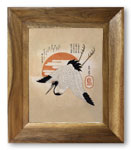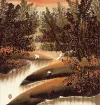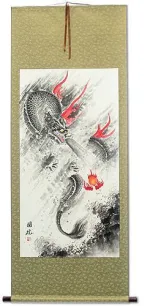Flying Crane Over Rising Sun
Japanese Fine Art Reproduction Scroll
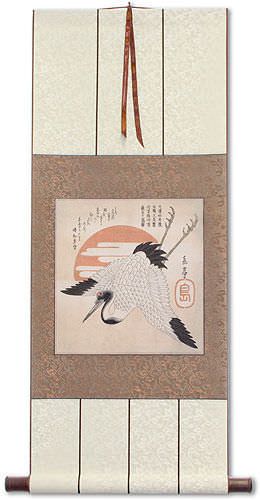

36¼"
18¼"
• Delivered to you in Columbus by Jan 16th.
• Standard shipping is just $3.80 for any order.
• 15 in stock now. Future supply uncertain.
• Handmade Wall Scroll.
• Money-Back Guarantee.

This crane artwork will look great in your home or office.
Approximate Measurements
Artwork Panel: 28.3cm x 29.7cm ≈ 11" x 11¾"
Silk/Brocade: 37.5cm x 92cm ≈ 14¾" x 36¼"
Width at Wooden Knobs: 46.5cm ≈ 18¼"
Information about caring for your wall scrollSee Larger Image
Flying Crane, Rising Sun
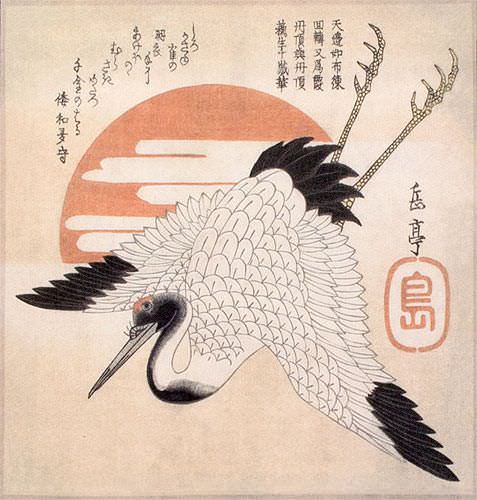
Close up view of the crane artwork mounted to this silk brocade wall scroll
This features an Asian crane flying across the red disc of the rising sun at the horizon.
I loved this image when I first saw it on the Metropolitan Museum of Art's website. This was a woodblock print created by 八島岳亭 (Yashima Gakutei) back in about 1835. All of the prints were created so long ago that they all show a loss of detail and portions were clipped. I spent many hours working on the restoration of the image. You can now enjoy how this would have looked 188 years ago, but for a price you can afford. I also cheated a little, as the original was a little over 8" (20cm) wide. Mine is almost 30% wider, so it makes a better presentation on your wall.
On the right, you will see the artist's given name, 岳亭, written vertically, in black characters. Below, a red stamp appears to be a circle around a 島 character. But the circle is actually a stylized 八 character (see the breaks at the top and bottom of that oval/circle? Those make it two strokes, hence 八). This is 八島 (Yashima), the artist's surname portion of his signature for this piece. Upon first glance, some may think it's just a circle around 島 (Note: 島 means island by itself).
At the top, there are some poems. On the right is a Chinese ode or poem that speaks of the horizon meeting the red-crowned crane over and over for rebirths that expand 1000 years of history in China. The text on this artwork is written in vertical columns, starting from the right, as all old Chinese writing does. Below, I typed it left-to-right to match the orientation of this text:
天邊如布練
回轉又為霞
丹頂與丹頂
蘇生千歲華
I have not found anyone who can translate the ancient Japanese poem on the upper left. The last characters on the far right are 倭和夛守. However, I am not sure of the third character. It seems to be a variant that is no longer used. It might be a variant of 多 or 尋, but nobody that looked at this was sure. Also not sure of the meaning, maybe a personal name.
The artist is believed to be the illegitimate son of Samura Hirata under the Totugawa Shogunate. His mother later married into the Yashima Clan, thus the artist taking the surname Yashima.
The unofficial Japanese title of this piece is 旭日飛鶴 (Kyokujitsu Hikaku) which means, "Sun Rising, Flying Cranes". However, this same title is given to many images of cranes flying by a sunrise.
Between the many hours I spent restoring the image quality, printer cost, ink, other labor, and other materials, I will never make any profit on these, but it's a labor of love. I really like this image and wanted to bring it to the world.
About Real Japanese Woodblock Prints
Woodblock printing, often considered the precursor to the modern printing press, was first developed in China and later brought to Japan, where artists refined the technique into a unique art form. In Japan, these prints are called 木版畫 ("Moku Hanga"). Most were created during the Edo period (1603–1867), though production continued into the early 20th century.
Japanese artists would first create a "template painting" depicting scenes of daily life, including women washing clothes, men writing poetry, samurai battles, and occasionally more dramatic subjects. These template images, known as 浮世絵 (Ukiyo-e, or "Floating World"), were then carved into wood by skilled artisans. Another specialist applied wet ink or pigments to the carved blocks, and a sheet of handmade paper was pressed on to create the final print. This collaborative process produced vibrant, detailed artworks much faster than hand-painting hundreds of copies.
About This Reproduction
Original Japanese woodblock prints from the Edo period can sell for $800 to $20,000. Our prints are high-quality reproductions, crafted to capture the look and feel of the originals, though experts will recognize them as reproductions.
We use authentic handmade kozo (mulberry) paper—the same paper Japanese printmakers used centuries ago. Archival, UV-resistant pigment inks ensure long-lasting color, with laboratory testing showing up to 95 years of fade-free enjoyment if kept out of direct sunlight. Each reproduction is carefully color-corrected and restored, bringing the Edo period artwork to life for your wall.

Photographer Jeremy Cowart and the Canon imagePROGRAF PRO-2000 giclée printer used to create these reproductions.
Printing on delicate handmade paper is challenging. After testing multiple high-end printers, we found the Canon imagePROGRAF PRO-2000 delivers the precision and quality needed, using 12 archival inks and 18,432 nozzles. Each print is then sent to our Beijing workshop, where it is mounted into a handmade wall scroll, ready-to-hang without the need for expensive framing, giving your piece an authentic Japanese look.
Because the original artist has long passed, these works are public domain. In some cases, we license high-resolution scans of original prints, or even scan 200-year-old originals ourselves. This dedication ensures you receive a stunning Japanese woodblock print reproduction at an affordable price, making traditional Asian art accessible to everyone.
Want a custom wall scroll or unique print size? Just contact us!
We can print larger sizes, choose your preferred paper texture, and select silk brocade colors. Ready-to-frame prints can ship in days, while custom wall scrolls may take several weeks. Either way, the result is a truly one-of-a-kind piece of Japanese art.
This item was listed or modified
Sep 24th, 2025
